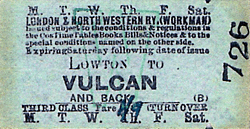Notes: Vulcan Halt was situated on the London & North Western Railway (LNWR) Earlestown – Winwick Junction line which had originally opened as part of the Warrington & Newton Railway on 25 July 1831. The line went on to become part of Britain’s first trunk route, the Grand Junction Railway (GJR) which provided a link between the Liverpool & Manchester Railway at Earlestown (originally Newton Junction) and Birmingham. A railway works had opened adjacent to the  Earlestown-Winwick line in 1832. Originally opened as the Charles Tayleur and Company it had become the Vulcan Foundry Ltd by 1898. Known as the Vulcan Works by the early twentieth century it had developed into one of the largest railway manufacturing facilities in the country. Earlestown-Winwick line in 1832. Originally opened as the Charles Tayleur and Company it had become the Vulcan Foundry Ltd by 1898. Known as the Vulcan Works by the early twentieth century it had developed into one of the largest railway manufacturing facilities in the country.
After the outbreak of the First World War on 4 August 1914 many railway works were used for the manufacture of war materials or munitions. The Vulcan Works was no exception and additional workers were taken on. In order to improve access to the factory for the workers the LNWR opened Vulcan Halt on 1 November 1916.
The halt was located on the west side of Wargrave Road. To the south of the halt there was a level crossing which provided a link from Wargrave Road to fields on the west side of the line. The halt was fairly basic consisting of two wooden platforms on which stood basic wooden waiting shelters.
On the south side of the level crossing on the west side of the line there was a signal box which controlled the level crossing and a connection to sidings in the works.
The halt was served by local trains operating between Warrington Bank Quay and Earlestown or St Helens.
After the war was over the halt remained open to serve the works and the July 1922 timetable showed 9 up and 6 down services Monday-to-Friday with a couple of extra trains on Saturdays. There were no trains on Sundays.
On 1 January 1923 Vulcan Halt became part of the London Midland & Scottish Railway (LMS). In 1926 Vulcan officially ceased to be a ‘halt’. The LMS summer timetable for 1932 showed 15 up and 13 down trains Monday-to-Friday with extra workings on Saturdays. There was 1 down train on Sunday evenings which was probably run to service an evening shift at the Vulcan works.
During the Second World War the Vulcan Works was once again used to support the war effort and Vulcan station would have been very busy.
The LMS summer timetable for 1947 showed 9 up and 8 down trains Monday-to-Friday as shown in the table below. There was one less up train on Saturdays.
Up Trains 1947 |
Destination |
Down Trains 1947 |
Destination |
5.35am |
Warrington Bank Quay |
7.06am |
St Helens |
7.32am |
Warrington Bank Quay |
7.36am |
Manchester Exchange |
7.38am |
Terminating service from St Helens |
9.11am |
St Helens |
9.19am |
Warrington Bank Quay |
10.51am |
St Helens |
12.22pm |
Warrington Bank Quay |
1.07pm |
St Helens |
1.16pm (Saturdays Excepted) |
Warrington Bank Quay |
2.20pm |
St Helens |
1.28pm (Saturdays Only ) |
Warrington Bank Quay |
4.32pm |
St Helens |
2.51pm |
Warrington Bank Quay |
5.37pm |
Newton-le-Willows |
4.42pm (Saturdays Excepted) |
Warrington Bank Quay |
|
|
5.52pm |
Warrington Bank Quay |
|
|
Vulcan station became part of British Railways [London Midland Region] (BR[LMR]) on 1 January 1948. It continued to serve the works throughout the 1950s and into the 1960s. By that time most of the services ran between Warrington Bank Quay and St Helens Shaw Street. The 1962 summer timetable showed 7 up trains Monday-to-Thursday and 8 on Fridays. There were 6 down trains Monday-to-Friday. On Saturdays there were 5 services in each direction and no trains called on Sundays.
In 1962/63 Vulcan once again became Vulcan Halt. The Reshaping of British Railways Report of 1963 (the Beeching Report) listed the services between St Helens & Warrington for withdrawal and Vulcan Halt for closure. The last trains ran on Saturday 12 June 1965 and Vulcan closed completely on 14 June 1965. Being a simple wooden structure it was quickly dismantled leaving little trace. The line remained open for passenger and goods services and remained so in November 2014.
The Vulcan Works closed in 2002 and was demolished in 2007.
Tickets from Michael Stewart and Brian Halford. Route map by Alan Young.
Sources:
- Britains First Trunk Line - The Grand Junction Railway - Norman W Webster - Adams & Dart 1972
- Railway Passenger Stations in Great Britain - A Chronology - Michael Quick - RCHS 2009
To see other stations on the Grand Junction Railway between Earlestown and Crewe click on the station name:
Winwick Quay, Warrington Dallam Lane, Warrington Bank Quay (1st), Moore, Preston Brook, Minshull Vernon and Coppenhall

The 8D Association - Dedicated to promoting the history of South Lancashire and North Cheshire railways. Web Site |











 Earlestown-Winwick line in 1832. Originally opened as the Charles Tayleur and Company it had become the Vulcan Foundry Ltd by 1898. Known as the Vulcan Works by the early twentieth century it had developed into one of the largest railway manufacturing facilities in the country.
Earlestown-Winwick line in 1832. Originally opened as the Charles Tayleur and Company it had become the Vulcan Foundry Ltd by 1898. Known as the Vulcan Works by the early twentieth century it had developed into one of the largest railway manufacturing facilities in the country. 



 Home Page
Home Page